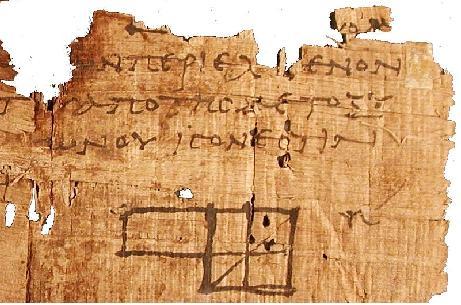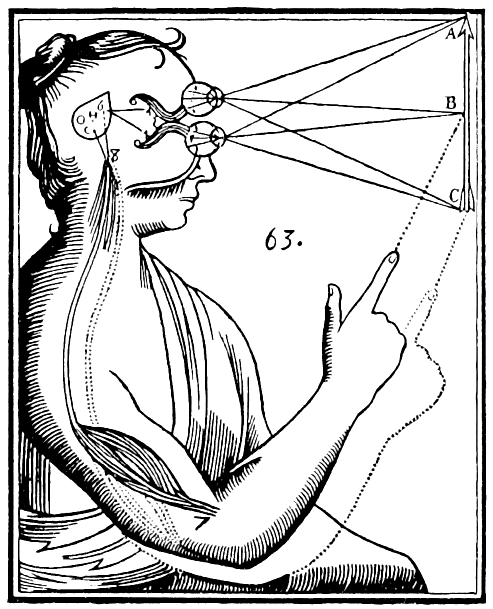Debate: Intromission vs. extramission theories of vision
One of the earliest ideas about vision is that it depends on light that streams out of the eye and detects surrounding objects. This view was attacked in its own time and disproved more than 2000 years later. Yet the idea of a beam leaving the eye persisted in beliefs both about the evil eye and the power of a lover's gaze. It is still widely held among both children and adults.
Theories of Vision: Extramission vs. Intromission
douglas goodwin, 2/3/16
Extramission theories

The eye obviously has fire within it, for when one is struck this fire flashes out. Vision is due to the gleaming
Alcmaeon of Croton (ca. 450 BCE)

Such fire as has the property, not of burning, but of yielding a gentle light, they [the Gods] contrived should become the proper body of each day. For the pure fire within us is akin to this, and they caused it to flow through the eyes.
Plato (427-347 BCE)
Theories of vision which depend on something streaming out of the eye, are known as extramission theories.

The mathematician Euclid (ca. 300 BCE), in his Optika, developed a rigorously and narrowly geometric extramission theory.
Rectilinear rays proceeding from the eye diverge infinitely [and] those things are seen upon which the visual rays fall and those things are not seen upon which the visual rays do not fall.
The astronomer and mathematician Ptolemy (127-148) carried Euclid's extramission ideas further and combined them with Galen's (129-199) work on the anatomy of the eye.
Into the Eye: Intromission Theories
There was an almost equally old but different view of vision among the Greek Natural philosophers, namely that vision involves something entering the eye from the object seen
They believed that isomorphic images (or eidola) streamed off objects and entered the eye, where they were sensed (2, 5). As Epicurus put it,
For particles are continually streaming off from the surface of bodies though no diminution of the bodies is observed ... And those given off maintain their position and arrangement. .. it is by the entrance of something coming from external objects that we see shapes and think of them
Lucretius (ca. 60 BCE) had a similar view. He called the images coming from objects simulacra; in his poem On the Nature of Things, he compared them to the skin cast off by cicadas and snakes and the membrane (caul) covering the head of a new born calf (5).
Aristotle (38-322 BCE) argued that the atomist view is wrong, because if objects put out copies of themselves, these would be objects themselves. This is impossible because ·the copies would overlap on their way to the eye and two objects can not be in the same place at the same time.
Aristotle claims that the Alcmaeon-Plato extramission view is also inadequate because it can't account for the light from stars.
In general it is unreasonable to suppose that seeing occurs by something issuing from the eye; that the ray of vision reaches as far as the stars, or it goes to a certain point and there coalesces with the object as some [Plato] think.
Aristotle developed a rather complicated intromission theory. To summarize:
Air and water contain a transparent medium that conducts light. The color of an object moves the transparent medium and since the medium is continuous between the object and the eye, movement of the medium is sensed by the eye, yielding visual sensation.

Ibn al-Haythem or "Alhazen"
(965- 1040)
- destroy all extramission theory.
- built a new intromission theory using the geometric ideas of Euclid and Ptolemy and the anatomical/physiological ideas of Galen.
Alhazen's theories lead directly to Kepler's (1571- 1630) theory of the retinal image and modern vision science.
What about the fire in the eye produced by pressing on the eye?
is this light?

Kepler believed that pressure on the eye produced light. Since he realized that the retina was the sensitive surface he assumed that deformation of the eyeball produced sparks which stimulated the retina. He decided that the sparks were produced by mechanical irritation of the iris because
light can impossibly have its seat in the lens or vitreous body because then it would disturb the process of vision

Descartes (1596-1650) rejected the idea of a physical light in the eye. He suggested that a blow on the eye produced vision in the same way he thought that light did, namely by moving the small fibers of the optic nerve.

Newton ( 1642-1727) also thought that rather than producing light, pressure on the eye mimicked the action of light on the retina (8):
Do not these colors arise from such motions, excited in the bottom of the eye by the pressure and motion of the finger, as, at other times are excited there by light for causing vision?
in 1719 the Italian anatomist Giovanni Morgagni pushed his eye to produce phosphenes and had his assistant look into his eye to see whether any light came out.
Even when [the assistant] observed extremely carefully and very bright light appeared to me [Morgagni] he could never observe any light by himself.
Georg Langguth, professor of anatomy and botany at the University of Wittenberg, extended Morgagni 's observations. To find out whether light is generated in the eye, he pushed his eye in the dark and, with a mirror, tried to see if light came out of his eye.
A friend, who became curious about these phenomena. . . visited me in the dark room. I briefly explained to him what I was doing. The doors were closed and I asked him to observe my eyes very closely. While I was perceiving the small light [the phosphenes], he was not able to observe any small flashes or oscillating light. Thereafter, he performed the same experiment on himself. . . I could never discover any light leaving his eyes (8).
popular views
The Evil Eye

"The evil eye approached and the storm sent no rain. ... the milk was no longer plentiful . . . the vigor of men was restrained. (Sumerian incantation, ca. 4000 BCE).
A glance of the Medusa turned men to stone. ... Simon ben Johai and Rabbi Jochanan could with their looks transform people into a heap of stones." (Talmud).
> Almost would the infidels strike thee down with their very looks when they hear the warning of the koran." (Koran).
Witches may kill by their looks. (G. Mackenzie, Laws and Customs of Scotland, 1674).
Love Beams

"My lady carries love within her eyes; All that she looks on is made pleasanter," "Whatever her sweet eyes are turned upon, Spirits of love do issue thence in flames" "In such eyes as hers are One surely stands whose glance can murder men'' "For me, out of her eyes comes the sweet light That makes me heedless of each other lady;"
Dante Alighieri
Love and Extramission
"A lover's eye will gaze an eagle blind" (William Shakespeare) "For your eyes, lady, caught and held me fast." (Francesco Petrarca) "The sparkling Glance that shoots Desire, Drench'd in these waves, does lose its fire." (Andrew Marvell) "What joyes shall seize thy soul, when she Bending her blessed eyes on thee (Those second smiles of Heav'n) shall dart Her mild rayes through thy melting Heart." (Richard Crashaw) "Love-darting eyes ... " (John Milton) "Then flash'd the living lightning from her eyes, And screams of horror rend th' affrighted skies." (Alexander Pope) "If beams from happy human eyes Have moved me not;" (Robert Lewis Stevenson) "Lesbia hath a beaming eye But no one knows for whom it beameth.' (Thomas Moore) "Lo! as that youth's eyes burned at thine, so went Thy spell through him, and left his straight neck bent." (Dante Gabriel Rossetti)
The Feeling of Being Stared At

... I have tested... the 'feeling of being stared at,' at various times, in series of laboratory experiments conducted with persons who declared themselves either peculiarly susceptible to the stare or peculiarly capable of 'making people turn around.' As regards such capacity, the experiments have invariably given a negative result. ..
Distinguished Professor of Psychology E. B. Titchener, 1898
--
your turn: debate!
- split into two teams: EXTRAMISSION and INTROMISSION
- both teams introduce their position
- debate
summary
extramission theory states that visual perception is accomplished by rays of light emitted by the eyes
intromission theory visual perception comes from some representative of the object entering the eyes.
DEBATE
- statement, extramission
- statement, intromission
- debate
- review and summary

